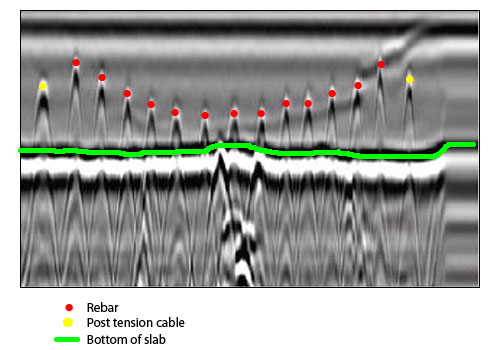Comprehensive Guide to Concrete Scanning Technologies
Comprehensive Guide to Concrete Scanning Technologies
Blog Article
Past the Surface: Leveraging Advanced Concrete Scanning Techniques for Unmatched Accuracy and Understanding
In the realm of building and infrastructure maintenance, the pursuit for precision and thoroughness is incessant. Advanced concrete scanning strategies have actually arised as crucial tools in this pursuit, supplying a glance under the surface area to unveil a world of vital insights. By harnessing sophisticated innovations, experts can discover anomalies, evaluate the condition of concrete frameworks, and make informed decisions that shape the course of jobs. The ramifications of these techniques prolong far past simple surface-level evaluations, promising a depth of accuracy and understanding that is unparalleled.
Importance of Advanced Concrete Scanning
The importance of using sophisticated concrete scanning techniques hinges on the exceptional precision they supply for discovering sub-surface abnormalities and making certain architectural integrity. By employing sophisticated modern technologies such as ground-penetrating radar (GPR), electromagnetic induction, and advanced finder imaging, construction specialists can dig beneath the surface of concrete structures with a level of accuracy that much surpasses traditional assessment methods. Concrete Scanning. These strategies allow the recognition of hidden risks like rebar corrosion, gaps, avenues, or post-tension cable televisions that might jeopardize the security and safety and security of a structure over time
In addition, progressed concrete scanning gives vital understandings right into the total condition of a concrete aspect without the need for invasive steps, minimizing the threat of creating damage throughout the analysis procedure. The capability to pinpoint the precise place and depth of possible issues permits for targeted repairs and maintenance, ultimately prolonging the life-span of the structure and maximizing its performance. Fundamentally, the significance of sophisticated concrete scanning can not be overemphasized in the realm of building and framework upkeep, where precision and integrity are critical.
Sorts Of Cutting-Edge Technologies

Abnormalities and Problem Detection
Along with GPR, concrete scanning techniques like thermography and impact-echo testing are also effective in detecting flaws and anomalies. Thermography uses infrared modern technology to recognize variations in surface temperature level, suggesting potential locations of problem such as delamination or wetness access. On the other hand, impact-echo testing includes evaluating acoustic reactions to find spaces, cracks, and various other flaws within the concrete. By leveraging these innovative techniques, specialists can proactively resolve architectural concerns, guaranteeing the long life and security of concrete structures.
Assessing Concrete Problem
Exactly his explanation how can designers properly examine the problem of concrete frameworks to guarantee their longevity and safety? Different sophisticated concrete scanning methods are used for this function. Ground-penetrating radar (GPR) is commonly used to assess the he has a good point interior framework of concrete, spotting gaps, fractures, and various other anomalies that might compromise its toughness.
Moreover, aesthetic inspection stays an essential component of concrete problem assessment. Engineers visually check out the surface area for indicators of degeneration, such as spalling, cracking, or staining. Integrating non-destructive testing approaches with aesthetic assessments permits a detailed evaluation of concrete problem, enabling engineers to determine potential issues beforehand and apply timely upkeep or fixings. By leveraging these sophisticated techniques, engineers can make sure the lasting toughness and safety and security of concrete structures.
Enhancing Decision-Making Procedures
In the realm of framework administration, enhancing decision-making procedures is vital for making sure the efficient maintenance and durability of concrete structures. Boosted decision-making procedures in concrete administration include making use of sophisticated scanning strategies to gather detailed information on the problem of frameworks. By leveraging innovations such as ground-penetrating radar and 3D imaging, stakeholders can make informed decisions pertaining to reinforcement, substitute, or repair techniques.
These progressed scanning strategies provide indispensable insights right into the internal make-up of concrete, recognizing potential concerns such as gaps, fractures, or deterioration that might not show up externally. This level of comprehensive details enables aggressive maintenance preparation, minimizing the danger of structural failures and increasing the overall life expectancy of concrete structures.
In addition, by incorporating electronic paperwork and analysis tools into the decision-making process, stakeholders can track the advancement of concrete conditions with time, making it possible for anticipating upkeep methods and enhancing source allotment. Inevitably, the assimilation of advanced concrete scanning methods boosts decision-making procedures by supplying unrivaled precision, insight, and performance in facilities administration.
Verdict
In verdict, advanced concrete scanning strategies provide unmatched accuracy and understanding in finding Get More Information anomalies, issues, and assessing the condition of concrete structures. By leveraging cutting-edge technologies, decision-making procedures can be boosted, causing even more reliable and enlightened services for preserving and repairing concrete facilities. These strategies play a vital role in guaranteeing the safety and security and longevity of concrete structures, making them a vital tool in the field of construction and engineering.
In addition, advanced concrete scanning supplies very useful insights into the general problem of a concrete element without the demand for invasive procedures, minimizing the risk of creating damage during the assessment procedure - Concrete Scanning. An additional cutting-edge modern technology is 3D X-ray scanning, which provides detailed photos of the interior structure of concrete, offering valuable details without the requirement for damaging screening. Furthermore, Concrete Cover Meters are utilized to gauge the density of concrete cover over reinforcement bars accurately. Improved decision-making processes in concrete monitoring involve using advanced scanning techniques to gather thorough data on the condition of frameworks.In verdict, advanced concrete scanning techniques supply unequaled precision and insight in discovering abnormalities, issues, and evaluating the problem of concrete frameworks
Report this page